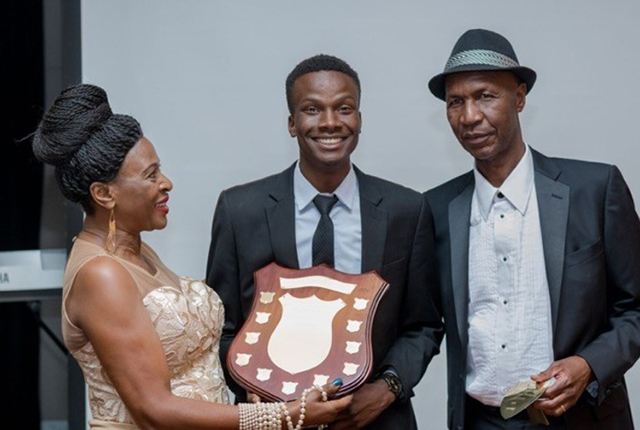Call for affordable housing solutions


Zimbabwe’s first black architect Mr Venon Mwamuka’s widow Margaret (left) and Beta Holdings chairman Mr Albert Nhau present Beshani Rondozai with the Best Architect Student Trophy recently
Sydney Kawadza Senior Features Writer
Authorities rarely talk of figures related to the ballooning housing backlog in Zimbabwe’s major cities. They seem to have just grown tired of crunching the numbers.Acting Harare Town Clerk Mrs Josephine Ncube revealed in December last year that at least 145 000 new applicants joined the council’s housing waiting list.
Quoting city council minutes of the Education, Health, Housing and Community Services and Licensing Committee, she said this was a 262 percent increase compared to 2014.Government puts the housing backlog at 1,25 million houses.The figures call for new thinking that could ease the challenge.
Beta Holdings, one of Zimbabwe’s largest brick and tile manufacturers, has introduced an award to promote the designing of affordable accommodation in Zimbabwe.They sponsor the Beta Holdings Architectural Students Awards that seeks to reward enterprising students who can come up with designs for low cost housing projects.
The competition’s inaugural winner, Beshine Rondozai (23), showed innovation was not in short supply in Zimbabwe.The final year student at the National University of Science and Technology said Zimbabweans could provide the solution to the challenges.
“The rate of rural to urban migration has seen high population densities within our urban cities, so too the cost of living, leaving low-income residents with fewer choices for affordable housing.
“The progressive solution is to provide adequate and economical living quarters to large groups of people.”He said current solutions imposed huge structures that are devoid of human scale.
“They discourage the sense of a community thus they appear to be isolated in appearance and the context in which they are designed are not conducive to the Zimbabwean situation.”
Rondozai said the zeal to provide housing solutions has left some crucial areas unchecked.The use of sustainable material, he said, was usually ignored despite the fact that they increase the construction costs.
“Worse still, the designs seem to lack environment consciousness.
“Thus, there is need for urban planners, designers and architects to come up with affordable housing solutions that address the issue of space provision at a cheaper cost and easy to maintain or which are rather naturally sustainable.”
His sentiments were echoed by Local Government, Public Works and National Housing Development chief architect Mr Chenjerai Bwerinofa who called for innovation and the development and nurturing of future architects and infrastructural design experts.He said housing development was an important agenda for the Government as it was a visible deliverable through which development can be measured.
“Government’s National Housing Policy recognises that professional institutes in the building environment such as the Institute of Architects, Engineers, Planners and Surveyors are directly involved in housing development and management, bringing different perspectives which make housing development and management responsive to people’s different needs,” he said.
Mr Bwerinofa said initiatives such as rewarding innovation reinforce the need for strategic and smart partnerships between Government and related fields.Government is targeting at least 313 638 housing units and serviced stands for low to medium income groups.
“It is noted that out of the one million home-seekers, 70 percent are low income while 30 percent are middle income.”This calls for new building technology and the use of suitable, affordable and environmentally compliant technologies that ensure quality in the production of housing units.
“Urban renewal seeks to redevelop areas considered to have lost, or are losing, their social, economic and environmental functionality.
“The challenge of the future is to build world-class cities and this starts with renewing the face and outlook of the commercial and residential buildings that make up our towns and cities,” Mr Bwerinofa said.
The Beta Holdings Architectural Students Awards are a tribute to Zimbabwe’s world renowned and first black architect Mr Vernon Benele Mwamuka.
According to Beta Holdings group chief executive Mr Godfrey Manhambara, Mr Mwamuka still stands out as one of the most prominent architects Zimbabwe has ever produced.
Mr Mwamuka was born on January 12, 1955 at Bonda Mission and did his primary education at Vengere Primary School in Rusape.He did his secondary education at St Augustine’s Mission, Penhalonga.After completing his studies – passing with flying colours, three A’s and a B in Maths, Physics, Biology and Chemistry – Mr Mwamuka briefly enrolled with the University of Zimbabwe in 1975.
He got a scholarship to study architecture at the University of Glasgow in Scotland, completing his studies in 1978.Mr Mwamuka proceeded to do a post-graduate diploma in architecture in London.After completing the diploma, Mr Mwamuka left for the United States where he worked for DBTM, an architectural firm, between 1979 and 1980.
He returned home in 1981 and joined the then Ministry of Construction before joining an architectural firm, Harvey Buffet.He rose to become a senior partner and the firm changed its name to Harvey Buffet Mwamuka Mercuri.
In the early 1990s, Mr Mwamuka broke away with another Italian born senior partner, Eugene Mercuri to form Mwamuka Mercuri and Associate Architects.
His architectural monuments includes Southampton Life Centre (now Intermarket Life Centre), Construction House, Kopje Plaza, Old Mutual Centre, Joina City (Harare), Africa University (Mutare), National University of Science and Technology (Bulawayo), the Harare Domestic Airport and the Bulawayo International Airport.
Mr Mwamuka died in a road accident on December 30, 2001 while returning from Bulawayo.He had attended the ground-breaking ceremony for the re-building of Bulawayo International Airport – renamed the Joshua Mqabuko Nkomo International Airport.
“All these completed commissions attest to Mwamuka’s creative identity.“His works have left a unique aesthetic impact on the immediate environment revitalising the surrounding urban expanse as in the case of the Kopje Plaza (West of Harare’s skyline).
“The Kopje Plaza changed the skyline of the Kopje area where a number of neglected buildings had become an eyesore and a sign of urban decay,” Mr Manhambara said.He described Mr Mwamuka as humble, true and principled professional.
“He helped many students and wanted more blacks to take on architecture as a career. He loved sciences and loved to help young people.”
Meanwhile, the design solution of the winning entry strives to create a contemporary urban landscape in sync with the nature.That is, topography, solar energy, water drainage, vegetation and urban land values as the dynamic contextual elements for a low cost housing scheme.
“Through the use of environmentally sustainable materials, clay brick and clay tiles . . . The community building on a larger scale has green spaces as soft landscaping which was uncommon to traditional low-cost housing characterised with hard landscaping summing up to an unsustainable living environment.”
The community building has 237 housing units from 104 detached houses, 31 semi-detached single story, 63 semi-detached double story and 39 semi-detached flats with three stories summing up to 652 family units within the three zones.It is set within a compact structure that maintains the human scale of low-density projects.
Each unit has its own terrace, balcony, or garden, while building features, like solar arrays and rainwater collection systems, emphasise sustainability and keep costs low.The low cost design solution addresses issues of providing decent spaces for living.
Attention was also put to new affordable housing units that incorporate sustainable features that reduce cost of construction and maintenance.
It is also designed to use sustainable materials that reduce energy use and above all, it is environmentally friendly.
Living spaces within the housing units are organised in a linear fashion to facilitate cross-ventilation.
A passive natural cooling technique that eliminates the need for energy-intensive rooftop air conditioning and electric fans which are an adaptive design solution to the ever increasing local temperatures will be used.
Housing units are oriented with the longer façade facing north to reduce the impact of solar heat and for effective cross ventilation, making the design environmentally responsive.The interior has framed views to the courtyard and/or green spaces providing a healthy environment.
Balconies face each other, minimising personification of common spaces synonymous with nature.
Feedback: [email protected]









Comments